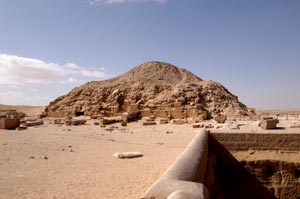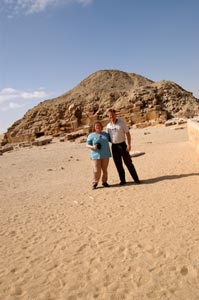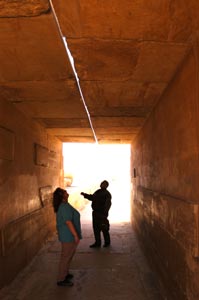










more photos
[ 1 ] [ 2 ]
site information
0900-1600 daily
E£20 entry
E£10 students
E£10 camera
E£100 video camera
avoid Friday, Sunday (crowded)
can also be reached by camel for E£150 (3 hours)
or by horse for E£100
(2 hours)
relevant links
history
old kingdom
dynasty III
djoser
sekhemkhet
dynasty IV
shepseskaf
dynasty V
unas
djedkare
dynasty VI
pepi I
Merenre
pepi II
details
57.5 m (188.6 ft) square
44m ( 141 ft) tall
(currently 19m)
56º 18' 35" angle
Pyramid of Unas
The Pyramid was closed when we went -- many of the sites in Saqqara are closed for renovations or restoration work -- and from the outside it doesn't look like much. A pile of limestone rubble in the vague shape of a pyramid originally 44 meters high, but squahsed down to less than 20 now. If you can scramble around the back side of the pyramid, there are a number of intact casing stones.

the collapsed and falling ruin of Unas' pyramid
The interior stone that is revealed, however, is roughly stacked rubble -- it looks hastily put in place and barely capable of supporting the weight of the limestone casing when the pyramid was finished.
According to the books,though, the interior is well preserved and contains beautiful heiroglyphs. Every inch of the burial chamber is covered in texts. There is a plain sarcophagus, which has been carefully decorated. The quality of the carvings here are rarely matched in Egyptian art.
 The
entrance is predictably on the north side down a steep
passageway to the burial chamber. Three granite portcullises
originally barred the way, an attempt to keep tomb
robbers from the treasures buried inside. The burial
chamber is plainly decorated except that the ceiling
is covered in 5-pointed stars (a pattern repeated
in the covered causeway outside) and a basalt sarcophagus.
It is the walls of the passage leading to the burial
chamber that are most interesting -- painted green
and containing the first known example of The Pyramid
Texts, which formed the basis for the reknowned
Book of the Dead.
The
entrance is predictably on the north side down a steep
passageway to the burial chamber. Three granite portcullises
originally barred the way, an attempt to keep tomb
robbers from the treasures buried inside. The burial
chamber is plainly decorated except that the ceiling
is covered in 5-pointed stars (a pattern repeated
in the covered causeway outside) and a basalt sarcophagus.
It is the walls of the passage leading to the burial
chamber that are most interesting -- painted green
and containing the first known example of The Pyramid
Texts, which formed the basis for the reknowned
Book of the Dead.
The pyramid was opened in 1881 by the director of antiquities and sponsored by Thomas Cook & Son. Tourists have been visiting it ever since.
A funerary temple stood to the east, although only a few walls remain and some pieces of granite floor. The temple is not half as impressive as the causeway connecting the funerary temple to a valley temple near the Nile almost 700 meters away.


A short piece of the causeway has been reconstructed, and the inscriptions inside show transportation of granite and the predictable "smiting scenes" of Unas over his enemies. There are also extensive famine scenes, with the figures carved in emaciated stick-figure form.
Most of what you see standingis reconstruction, but parts of the causeway itself were found intact. The angled slit in the ceiling is designed to let in light, but not let it fade the colorful reliefs, and to divert any rain that might fall.